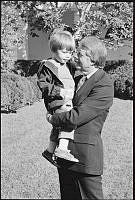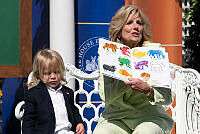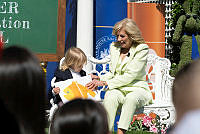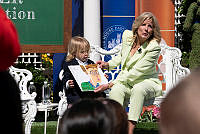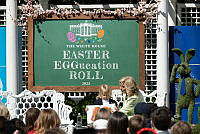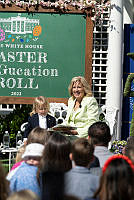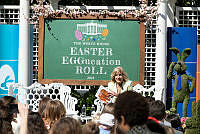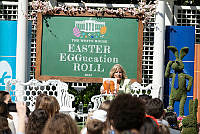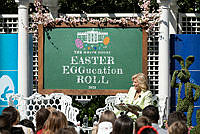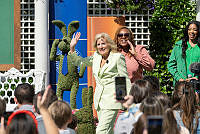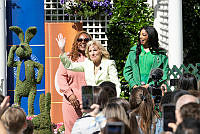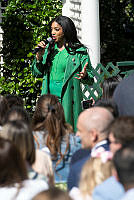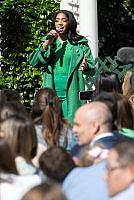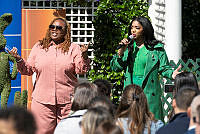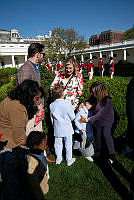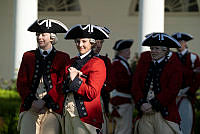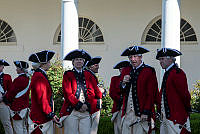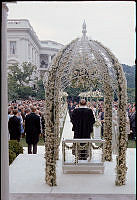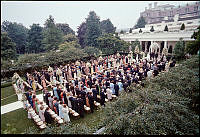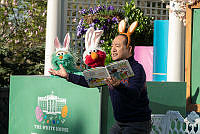President Kennedy's Rose Garden
Copyright © White House Historical Association. All rights reserved under international copyright conventions. No part of this article may be reproduced or utilized in any form or by any means, electronic or mechanical, including photocopying, recording, or by any information storage and retrieval system, without permission in writing from the publisher. Requests for reprint permissions should be addressed to books@whha.org
The inspiration for renewing the rose garden at the White House came from President Kennedy in 1961. My involvement began at a picnic on a hazy summer day in August at our beach house on Cape Cod, surrounded by sand dunes, the sea, and sailboats. It was a picnic for a few friends and included President and Mrs. Kennedy. Hardly had the President came ashore from his boat when he suggested we sit down and discuss a garden for the White House.
He and Mrs. Kennedy had just returned from a state visit to France, followed by stops in England and Austria. The President had noted that the White House had no garden equal in quality or attractiveness to the gardens that he had seen and in which he had been entertained in Europe. There he had recognized the importance of gardens surrounding an official residence and their appeal to the sensibilities of all people.
He wanted to start, in the greatest haste, to remake the area near his office at the west end of the White House, known as the Rose Garden, into an area both useful and attractive. Would I design it for him? It was a startling request to say the least.
As an amateur, I questioned my ability to design a garden of such importance. Paying little attention to that doubt, he bubbled with enthusiasm, with fascinating details of how he wanted a garden to appeal to the most discriminating taste, yet a garden that would hold a thousand people for a ceremony. What gardener could resist? I agreed, on the spot, to meet in September.
Time passed, and the day came when I called the White House as promised and spoke to J.B. West, the chief usher, who arranged a day for our meeting in the garden. Perry Wheeler, a friend and a landscape architect living and practicing in Washington, agreed to come with me. He seemed to me a likely collaborator. I was fortunate in this choice for from the beginning to the end of the project, he remained always interested, always helpful, and ever the honest critic.

A saucer magnolia outside the Oval Office.
Bruce White for the White House Historical AssociationI vividly remember my first impression of the scene and the setting for the projected garden. The White House proper seemed exceptionally tall where it joined the long, low colonnade that linked it to the Oval Office and Cabinet Room. There were no trees near this wing or the corner by the White House, except for Andrew Jackson’s tall, dark Magnolia grandiflora near the South Portico. Beneath the magnolias was a long semicircular white bench on which Perry Wheeler and I sat facing the President’s office.
The garden had a simple plan. Four rows of clipped privet hedges about four feet tall ran the full length. In the plan of parallel lines were tucked away Tom Thumb roses and occasional standard roses. We sat a long time trying to imagine how this area could be designed to reflect the requirements the President had so clearly outlined to me that day at the Cape.
Beyond the colonnade, the door of the Oval Office opened suddenly, and the President came out and in his usual brisk way crossed the lawn to greet us. His first words were, “What do you think can be done? Have you any ideas?” Although I had no thoughts of what to do at the moment, President Kennedy’s enthusiasm and interest were so contagious that I felt I must certainly find him a good solution.
I explained that I would have to think about it now that I had seen the space. The tall central block of the White House in one corner and the West Wing, with its two low colonnades forming boundaries west and north, would have to be united in a harmonious and uncomplicated way. To the south there was no “wall” of architecture, just open space.
After that first impression of the garden and my talk with the President, my sense of responsibility for redesigning the garden was very strong. I hoped to find an inspiration that would help me bring all of the President’s requirements together. It was not until the end of October—the trees had lost their leaves—when late one afternoon, cold with the feeling of approaching winter and descending darkness, I was walking along Fifth Avenue in New York and looked up and saw three lovely magnolia trees growing in front of the Frick museum.

The saucer magnolias transplanted from the Tidal Basin continue to thrive in the Rose Garden today.
Bruce White for the White House Historical AssociationI had often admired these trees before, but this evening they had a special importance to me. Their pale silvery branches with heavy twigs seemed to retain the light of summer. I knew their pattern of growth would continue to give form in winter and would catch raindrops as well as tufts of falling snow. I felt I could now design the President’s garden!
I envisioned all four corners planted with Magnolia soulangeana. These trees would soften the difficult corners that were now bare and would permit sufficient light to fall beneath and around them to allow planting. A 50-by-100-foot lawn, large enough to accommodate a thousand people for ceremonial activities and receptions and small enough to be covered by a tent, would be in the center of the garden.
On either side of the large lawn there could be a border 12 feet wide in which to plant smaller trees, roses, and other flowers. The President loved flowers and asked if a variety of other types could be mixed with the roses. He had read the published garden notes of Thomas Jefferson and hoped for flowers used in Jefferson’s period.
At the west end near his office, the steps were to be redesigned for the President wanted them to serve both as steps and as a platform or stage. A central step was to be wider than the others, so that he could stand a little above the heads of the crowd in order that they might see and hear him more clearly. Above this “platform step” were to be three others, upon which those being honored would stand, above the President.
Opposite the steps, at the east end of the garden, a flagstone terrace was to be laid under the historic Magnolia grandiflora. Here the President wished to have a place where he could sit and entertain his guests or, perhaps, hold a small luncheon.
I had before me an interesting problem involving a fascinating place. The site had once been a stable yard; but due to its location beneath the great windows of the State Dining Room, the stable was soon relocated. Vegetables had been planted there by President Grant. In the range of rooms along the colonnade had been a milk house, icehouse, workshops, servants’ dwelling rooms, and numbers of other small, thick-walled chambers called, in the earliest times, household “offices.”

The Rose Garden as planted in 1913 according to First Lady Ellen Wilson's modifications of plans by George Burnap.
Library of CongressThe first rose garden known there had been a dream-like Victorian garden under glass, part of a large complex of greenhouses begun before the Civil War. A “rose house” was only part of the vast glazed domains, which also had rooms for palms, orchids, fruit trees, and camellias. As the greenhouses grew, their magnificence increased. The rose house, as it was called was a plain, but very tall, rectangular glass structure that fit into the ell of the West Wing, the area of the present Rose Garden. Inside, the roses, planted in rows, were “farmed” more than being set out ornamentally. These rows were crisscrossed by water pipes with low sprinklers. Canvas curtains, like the studio curtains in La Boheme, protected the masses of delicate blossoms from violent summer sunshine.
Mrs. Theodore Roosevelt planted what she called her “Colonial Garden” on the spot in 1902, following the removal of the greenhouses by Charles McKim of the architectural firm McKim, Mead & White. Her charming portrait in the White House shows her seated in the Colonial Garden on a pretty wooden bench, with the South Portico in the background. Here she wanted only sweet peas, black-eyed susans, quince—and the jasmine in which she and Theodore Roosevelt took great delight on summer evenings, as they sat in white painted rocking chairs on the South Portico.
Through time, the White House has had occupants who have loved gardens and some who have not. Even among the “gardeners,” there were different preferences. Mrs. Taft, for example, preferred potted tropical plants inside to flower beds outside.
The one flower that unites all the occupants through the history of the White House is the rose. Thus, for most of the 20th century, the Rose Garden has been a rose garden. Now, in 1961, President Kennedy wanted it restored in spirit but revised to become more than just a private garden.
My theory of garden design calls for an overall outline, which I call the “bone structure,” the most important element. Designing a garden is not unlike designing a building: You begin with the skeleton sketch, a general pleasing outline or form, and proceed from there. Within this structure, you can make subdivisions as you choose, more complicated or more detailed than the general form.

During the Lyndon B. Johnson administration, Rachel Mellon also supervised the redesign of the East Garden seen here in 2011. In 1965, it was renamed the Jacqueline Kennedy Garden.
White House Historical AssociationIn late November my husband and I were invited to dinner at the White House; Pablo Casals was to play. I was seated across the table from the President.
He looked over to me before sitting down and said with an inquiring smile, “Bunny, where is my garden plan?” “I’m afraid it is still in my head, Mr. President, not yet down on paper, but I will finish it and send it to you soon.” “That’s the story of my administration,” he quipped, with a sparkle and a twinkle in his eye.
This informal exchange, brief as it was, spurred me to move ahead more quickly. A plan went down on paper, and I sent it to the President for approval. Within two days, I received his note of acceptance. I would have the cooperation of the National Park Service. All costs would be covered by the Park Service, but I was to keep expenses as low as possible.
An important first step was to find someone to manage and implement the work of the Rose Garden. There was an official over the gardens and grounds at the White House, but we needed a specialist with varied experience who understood all aspects of the undertaking. I set out to study local National Park Service gardens. One day in the Kenilworth Aquatic Gardens in Washington, D.C., I met Irvin Williams, the head horticulturist, who was also in charge of the government nursery on Dangerfield Island in the Potomac, where the choice of plant material was the largest and the quality the highest. Talking with Mr. Williams, I felt almost immediately that he was the right man to direct and oversee the new garden at the White House, as well as to make other improvements to the White House grounds.
I spoke to Mrs. Kennedy about this, with the hope that if he were willing, Mr. Williams could be transferred by the Park Service to become head gardener at the White House. This strategy worked out well for everyone, and Mr. Williams soon took up his duties there, becoming involved with all the details of building a new garden. Much of the beauty of the White House landscape today is to his credit, as is the quality of the Rose Garden and the corresponding Jacqueline Kennedy Garden on the east side of the house. He has remained ever since as the guiding spirit of the work begun in 1962.
J.B. West helped complete our management team at the White House. He was the chief executive officer in charge of White House operations and had been there since the 1930s. He knew the schedule and activities of the President and his family and how we could adjust our building program to minimize their inconvenience.
Both Mr. Williams and Mr. West lent their intelligence—not to mention their charm—to the project; their spirits are woven into the planting of the Rose Garden. The mention of their names recalls the ups and downs we experienced. One day while were removing the old soil and replacing it with new, we cut into a mysterious cable buried in a corner of the garden. It turned out to be the hot line that set off the nation’s military alert.
The scene was suddenly alive with security guards, to the alarm of everyone. We learned that the cable had been hastily installed during World War II by the Navy. Records of its location were inaccurate, hence our innocent intrusion. This startling experience was handled with calmness; not even the President reprimanded us for the deep digging. However, months later he asked me if I had found any other interesting objects in my gardening pursuits!
We continued to dig. The garden area was filled with rubble and relics and yielded many curiosities, such as Civil War horseshoes and bits of pots from the old greenhouses. We dug out the whole area to a depth of four feet and filled it with fertile soil. With new soil in place and Mr. Williams at work, my thoughts turned to finding available plant material. The magnolias I imagined planting there would be hard to find.
There were, however, seemingly forgotten groves of interesting trees in the vast public land of the federal city, where old plant material had been allowed to grow in a state of apparent abandon. Near the Tidal Basin and behind the rambling wartime Navy buildings (since torn down) I finally found the four magnolias. Forgotten for many years, these trees had survived both men and war. They were balled and burlapped and moved by a crane from obscurity to the White House, where they took root in President Kennedy’s Rose Garden.
Their presence changed the entire character of this empty space. Their natural untended growth filled the four bare corners. The tree whose trunk reached higher than the others was planted in the northeast corner by the White House. Crowded by other trees in its previous planting ground, this magnolia had reached toward the light; it had gained a height not often found in Magnolia soulangeana, which tend to spread after a certain period of upward growth.
When the planting was completed, the trees were pruned to give them strength and to create the shape each corner demanded. The special pruning was done by Everett Hicks, an exceptional man in his field. He had been trained by, and spent most of this life with, the Davey Tree Company. He combined a knowledge of pruning large trees with the eye and talent of a sculptor. These magnolias, my original inspiration, were not disappointing when they were in place. They gave life to what had been a cold, bleak space.
There is often unspoken encouragement when trees or shrubs are planted and you review the original plan to see how the reality of three dimensions measures up. Now in the Rose Garden shadows gave a quality of aliveness that could be repeated by the smaller trees I hoped to plant in the two flanking twelve-foot borders. The length of the borders would allow for five trees on each side. The force of the summer sun that bakes the city of Washington would be broken by the height and width of these trees.
The trees we chose were Katherine crab apples. Crab apples belong to the rose family and would blend well with the roses, perennials, annuals, and herbs that would grow beneath and around them. Aware that the garden would be used almost every day of the year and that the President had high hopes for it, I decided to divide the long beds into sections. The design, with a crab apple as the center of each section, would repeat itself and run like a ribbon the length of both beds.
A large diamond-shaped outline of santolina would surround each crab-apple tree. Each diamond would be set in a larger outline: a small clipped English boxwood hedge and, next to the lawn, a low growing hybrid boxwood called Greenpillow, developed by Henry Hohman in Kingsville, Maryland.
The divisions gave the garden its own pattern, not unlike an early American garden in Southern Virginia, in which the earth could be left bare if need be and the garden would still have form. The well-outlined areas could be bedded out as the season demanded: but the roses could remain, planted in the corners and edges as a strong accent woven into the tapestry of flowers that would change with the seasons.

The Rose Garden, walled on two sides by the colonnade of the West Wing, frames a view toward the Cabinet Room and the Oval Office.
The White House Historical AssociationIn spring there would be flowering bulbs, such as tulips, with a border of lapis blue Mùscari. In summer the border would be changed to plants of dark lavender heliotrope, while larger sections would have pale pink geraniums, lilies, white dianthus, blue salvia, lady’s mantle, cosmos, and lemon verbena, to mention a few. In fall the plants would be lifted again to allow for planting of chrysanthemums, Anemone japonica, and Michaelmas daisies. As winter approached, the garden would be put to bed, only the roses would remain, while the soil was being fertilized and turned over.
To facilitate this plan, a government greenhouse in Maryland was renovated to meet the changing needs of the Rose Garden. Perennials could be held over, annuals started, and lilies grown in pots so that they could be used year after year. In this way there was assurance that the garden would have the important plants that were required for each season.
At the east end opposite the President’s office, the openness created by the tall trunks of the old magnolias had to be filled in to give privacy and to outline the paved terrace. This was done with hawthorns and mixed varieties of hollies. The East Palatka holly used here was repeated in the bed near the President’s office.
The garden was begun in the spring of 1962 and finished at the end of the same year. It was truly President Kennedy’s garden. His concern for the growth and wellbeing of this garden was never ending. Often in the late afternoon working there by myself, changing and pruning plants, I would notice that his door would be open. He would be working at his desk. I was aware of and touched by the serious tranquility of this scene. As he left the office, he always stopped to say, “Hi,” or “How is the garden doing?”
Twenty years have gone by. The Rose Garden has seen administrations come and go. It is now known the world over. It has fulfilled John F. Kennedy’s vision of a garden that would endure and whose atmosphere, with the subtlety of its every changing patters, would suggest the every changing pattern of history itself.













